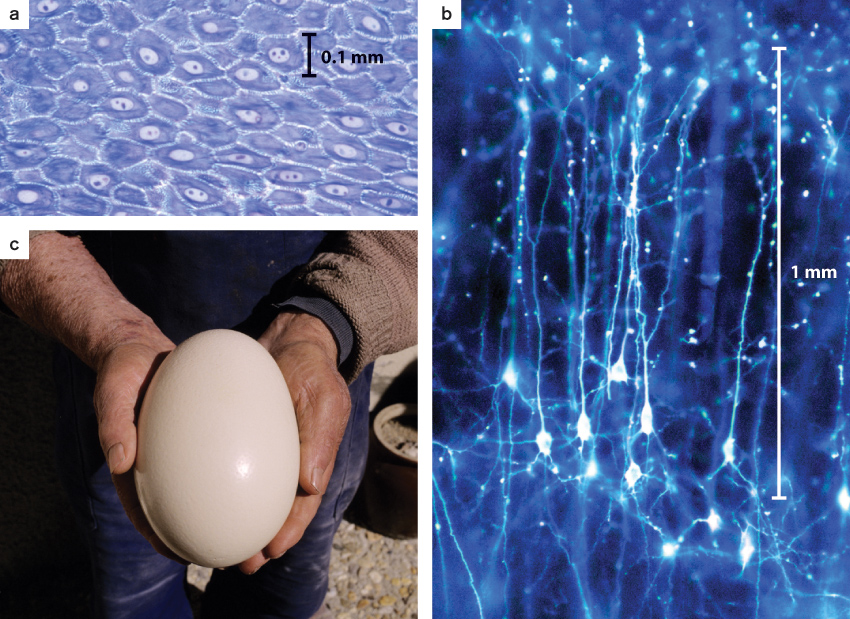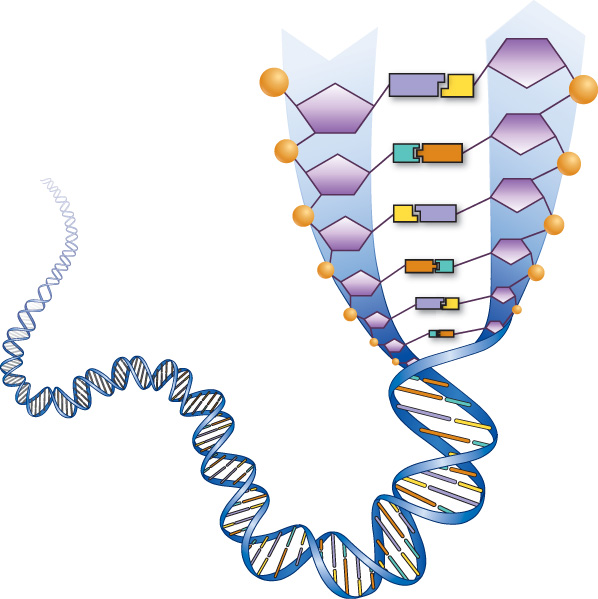1.3 THE CELL

To understand the universal features of life, we need to know what constitutes the minimal unit that can be considered alive. The cell is the simplest entity that can exist as an independent unit of life. Every known living organism is either a single cell or an ensemble of many cells (Fig. 1.10). Most bacteria (like those in Pasteur’s experiment), yeasts, and the tiny algae that float in oceans and ponds spend their lives as single cells. In contrast, multicellular plants and animals contain billions to trillions of cells that function in a coordinated fashion.
1-9
1-10
Most cells are tiny, their dimensions well below the threshold of detection by the naked eye (Fig. 1.11). The cells that make up the layers of your skin (Fig. 1.11a) average about 100 microns or 0.1 mm in diameter, which means that about 10 would fit in a row across the period at the end of this sentence. Many bacteria are less than a micron long. Certain specialized cells, however, can be quite large. Some nerve cells in humans, like the ones pictured in Fig. 1.11b, extend slender projections known as axons for distances as great as a meter, and the cannonball-size egg of an ostrich in Fig. 1.11c is a single giant cell.

The types of cells just mentioned—bacteria, yeast, skin cells, nerve cells, and an egg—seem very different, but all are organized along broadly similar lines. In particular, they all contain a stable blueprint of information in molecular form; they have a discrete boundary that separates the interior of the cell from its external environment; and they have the ability to harness materials and energy from the environment.
1.3.1 Nucleic acids store and transmit information needed for growth, function, and reproduction.

The first essential feature of a cell is its ability to store and transmit information. To accomplish this, cells require a stable archive of information that encodes and helps determine their physical attributes. Just as the construction and maintenance of a house requires a blueprint that defines the walls, plumbing, and electrical wiring, organisms require an accessible and reliable archive of information that helps determine their structure and metabolic activities. Another hallmark of life is the ability to reproduce. To reproduce, cells must be able to copy their archive of information rapidly and accurately. In all organisms, the information archive is a remarkable molecule known as deoxyribonucleic acid or DNA (Fig. 1.12).
DNA is a double-stranded helix, with each strand made up of varying sequences of four different kinds of molecules connected end to end. It is the arrangement of these molecular subunits that makes DNA special; in essence, they provide a four-letter alphabet that encodes cellular information. Notably, the information encoded in DNA directs the formation of proteins, the key structural and functional molecules that do the work of the cell. Virtually every aspect of the cell’s existence—its internal architecture, its shape, its ability to move, and its various chemical reactions—depends on proteins.
How does the information stored in DNA direct the synthesis of proteins? First, existing proteins create a copy of the DNA’s information in the form of a closely related molecule called ribonucleic acid, or RNA. The synthesis of RNA from a DNA template is called transcription, a term that describes the copying of information from one form into another. Specialized molecular structures within the cell then “read” the RNA molecule to determine what building blocks to use to create a protein. This process, called translation, converts information stored in the language of nucleic acids to information in the language of proteins.

The pathway from DNA to RNA (specifically to a form of RNA called messenger RNA, or mRNA) to protein is known as the central dogma of molecular biology (Fig. 1.13). The central dogma describes the basic flow of information in a cell and, while there are exceptions, it constitutes a fundamental principle in biology. As proteins are ultimately encoded by DNA, we can define specific stretches or segments of DNA according to the proteins that they encode. This is the simplest definition of a gene: the DNA sequence that corresponds to a specific protein product.
DNA has another remarkable feature. In addition to storing information, it is easily copied, or replicated, allowing genetic information to be passed from cell to cell or from one organism to its progeny. Each organism’s DNA archive can be stably and reliably passed from generation to generation in large part because of its double-stranded helical structure. During replication, each strand of the double helix serves as a template for a new strand. Replication is necessarily precise and accurate because mistakes introduced into the cell’s information archive may be lethal to the cell. That said, errors in DNA can and do occur during the process of replication, and environmental insults can damage DNA. Such changes are known as mutations; they can spell death for the cell, or they can lead to the variations that underlie the diversity of life and the process of evolution.
1-11
Question Quick Check 3
jTRvYHrZO9a3ORSU1BOZxop+q/ONawRorkFpCJXBPLt/ACZh/0Z0nXvhRET7er3ayxV3bUre8lotL2yhGwBY3sypos32B9eG1v5ODHWiL4z9Z+2xaqfJfk2ITPbhCj+A1.3.2 Membranes define cells and spaces within cells.
The second essential feature of all cells is a plasma membrane that separates the living material within the cell from the nonliving environment around it (Fig. 1.14). This boundary between inside and outside does not mean that cells are closed systems independent of the environment. On the contrary, there is an active and dynamic interplay between cells and their surroundings that is mediated by the plasma membrane. All cells require sustained contributions from their surroundings, both nutrients and the building blocks required to manufacture macromolecules. They also release waste products into the environment. As discussed more fully in Chapter 5, the plasma membrane controls the movement of materials into and out of the cell.

In addition to the plasma membrane, many cells have internal membranes that divide the cell into discrete compartments, each specialized for a particular function. A notable example is the nucleus, which houses the cell’s DNA. Like the plasma membrane, the nuclear membrane selectively controls movement of molecules into and out of it. As a result, the nucleus occupies a discrete space within the cell, separate from the space outside of the nucleus, called the cytoplasm.
Not all cells have a nucleus. In fact, cells can be grouped into two broad classes depending on whether or not they have a nucleus. Cells without a nucleus are prokaryotes, and cells with a nucleus are eukaryotes.
The first cells were prokaryotes. They evolved about 4 billion years ago, and their descendants include familiar bacteria that are around today. They are found wherever life can persist. Some prokaryotes live in peaceful coexistence with humans, inhabiting our gut and aiding digestion. Others cause disease—salmonella, tuberculosis, and cholera are familiar examples. Their success depends in part on their small size, their ability to reproduce rapidly, and their ability to obtain energy and nutrients from diverse sources. Most prokaryotes live as single-celled organisms, but some have simple multicellular forms.
1-12
Eukaryotes evolved much later, roughly 2 billion years ago, from one lineage among a diversity of prokaryotes that existed at the time. They include familiar groups such as animals, plants, and fungi, along with a wide diversity of single-celled microorganisms called protists. Eukaryotic organisms exist as single cells like yeast or as multicellular organisms like humans. In multicellular organisms, cells may specialize to perform different functions. For example, in humans, muscle cells contract; red blood cells carry oxygen to tissues; and skin cells provide an external barrier.
The terms “prokaryotes” and “eukaryotes” are useful in drawing attention to a fundamental distinction between these two groups of cells. However, today, biologists recognize three domains of life—Bacteria, Archaea, and Eukarya (Chapters 26 and 27). Bacteria and Archaea both lack a nucleus and are therefore prokaryotes, while Eukarya are eukaryotes. In spite of the similar cellular organization of Bacteria and Archaea, the Eukarya and Archaea are more closely related to each other than either is to Bacteria. Archaea are single-celled microorganisms, many of which flourish under seemingly hostile conditions, such as the hot springs of Yellowstone National Park.
1.3.3 Metabolism converts energy from the environment into a form that can be used by cells.
A third key feature of cells is the ability to harness energy from the environment. Let’s go back to our example of eating an apple. The apple contains sugars, which store energy in their chemical bonds. By breaking down sugar, our cells harness this energy and convert it into a form that can be used to do the work of the cell. Energy from the food we eat allows us to grow, move, communicate, and do all the other things that we do.
Organisms acquire energy from just two sources—the sun and chemical compounds. Regardless of their source of energy, all organisms use chemical reactions to break down molecules, releasing energy in the process and storing it in a chemical form called ATP (adenosine triphosphate) that cells can use. The term metabolism describes chemical reactions that cells use to convert energy from one form to another and to build and break down molecules. These reactions are required to sustain life.
Many metabolic reactions are highly conserved between organisms, suggesting that they evolved early in the history of life and have been maintained for billions of years because of their fundamental importance to cellular biochemistry.
1.3.4 A virus is genetic material in need of a cell.
It’s worth taking a moment to consider viruses. A virus is an agent that infects cells. It is smaller and simpler than cells. Why, then, aren’t viruses the smallest unit of life? We just considered three essential features of cells—the capacity to store and transmit information, a membrane that selectively controls movement in and out, and the ability to harness energy from the environment. Viruses have a stable archive of genetic information, which can be RNA or DNA, and the genetic material of viruses is surrounded by a protein coat and sometimes a lipid envelope. But viruses cannot harness energy from the environment. Therefore, on their own viruses cannot read and use the information contained in their genetic material, nor can they regulate the passage of substances across their protein coats or lipid envelopes the way that cells do. To replicate, they require a cell.
A virus infects a cell by binding to the cell surface, inserting its genetic material into the cell, and, in most cases, using the cellular machinery to replicate its own genetic material, synthesize proteins, and produce more viruses. In this way, it is often said that a virus “hijacks” a cell. The infected cell may produce more viruses, sometimes by lysis, or breakage, of the cell, and the new viruses can then infect more cells. In some cases, the genetic material of the virus integrates into the DNA of the host cell.
We discuss viruses many times throughout the book, as they are interesting in themselves and infect all kinds of cells. Each species of Bacteria, Archaea, and Eukarya is susceptible to many types of virus that are specialized to attack its cells. Several hundred types of virus are known to infect humans, and the catalog is still incomplete. Useful tools in biological research, viruses have provided a model system for many problems in biology, including how genes are turned on and off and how cancer develops.